Colloquia for Spring 2011
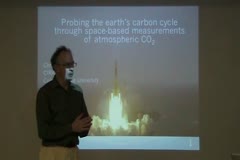
Probing the earth's carbon cycle through spaced-based measurements of atmospheric CO2
April 28, 2011
Chris O'dell
Hosted by Scott Denning
About half of the 30 billion tons of carbon dioxide emitted into the atmosphere each year by human activities is reabsorbed by the oceans and land biosphere. However, we do not know the geographic distribution of the "CO2 sinks" or if this process will continue unchanged as emissions increase and the climate evolves. Understanding these processes is essential for predicting the rate of…
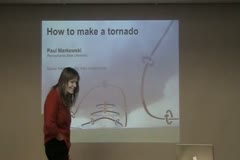
How to Make a Tornado
April 21, 2011
Paul Markowski
Hosted by Sue van den Heever
I will examine the mechanisms of tornadogenesis within atmospheric convection with the aid of vortex lines. The three-dimensional perspective provided by vortex lines can expose dynamics that may not be as apparent in inspections of only one vorticity component at a time. Although the presence of horizontal buoyancy gradients and baroclinic vorticity generation can complicate vortex line…
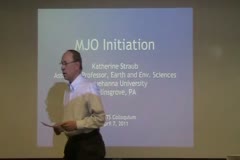
MJO Initiation
April 07, 2011
Katherine Straub
Hosted by Wayne Schubert and Dick Johnson
Although the Madden-Julian Oscillation (MJO) has now been studied for 40 years, terms like “MJO initiation†remain mysterious. Does “MJO initiation†mean the onset of deep convection in the Indian Ocean? Or can MJO initiation occur anywhere? Does initiation necessarily imply the onset of convection? Or could it be tied to winds? Or moisture? Can initiation really be…
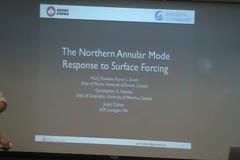
The Northern Annular Mode Response to Surface Forcing
March 31, 2011
Paul Kushner
Hosted by Thomas Birner
This talk discusses how Arctic Oscillation/Northern Annular Mode (AO/NAM) variability is related to surface forcing from the tropics and extratropics. In observations and GCMs, a lot of wintertime tropospheric AO/NAM variability is tied to the amount of wave activity that propagates into the polar stratosphere. I will show that much of this wave activity variability is simply related to how…
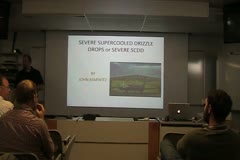
Severe Super-cooled Drizzle Drops
March 24, 2011
John D. Marwitz
Hosted by Tristan L’Ecuyer
he University of Wyoming instrumented the Wyoming King Air 200 in 1976. The aircraft instrumentation documents both the atmospheric environment and the response of the aircraft to this environment. This state-of-the-art cloud physics aircraft has been operated in support of various weather modification and in-flight icing projects. These projects involved the search for super cooled liquid…
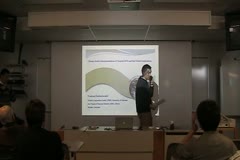
Climate model misrepresentations of Tropical SSTs and their global implications
March 10, 2011
Prashant Sardeshmukh
Hosted by Eric Maloney
Recent 50-yr trends of surface temperature and precipitation around the globe have been strongly influenced by the warming trend of the tropical oceans. The current generation of coupled climate models with prescribed changes in radiative forcing generally fail to capture the spatial structure of these trends. On the other hand, even uncoupled atmospheric models without prescribed changes in…
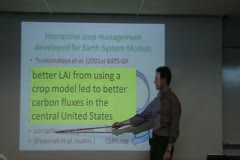
Improved Land-Atmosphere Fluxes From Including Interactive Crop Management In The Community Earth System Model
March 03, 2011
Sam Levis (NCAR)
Hosted by Colette Heald
Some Earth System Models include crop-specific algorithms for the simulation of interactive planting, growth, and harvesting, to better represent effects of human management on land surface properties with minimal need for new data sets. We evaluate such a model (the CESM1) with two present-day coupled atmosphere- land (CAM4/CLM4CN) simulations: A CONTROL that represents crops as unmanaged…
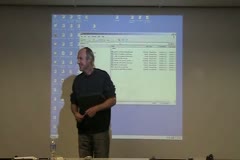
CIRA Intro Jamboree
February 24, 2011
CIRA Senior Scientists
Hosted by Chris Kummerow
5-10 min intros by CIRA senior scientists giving overviews of their research areas and groups.
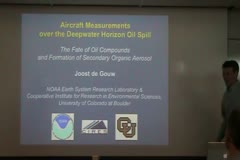
Aircraft Measurements over the Deepwater Horizon Oil Spill: The Fate of Oil Compounds and Formation of Secondary Organic Aerosol
February 17, 2011
Joost de Gouw (NOAA)
Hosted by Sonia Kreidenweis
An extensively instrumented NOAA WP-3D research aircraft made airborne measurements of the gaseous and aerosol composition of air over the Deepwater Horizon (DWH) oil spill that occurred in April-July of 2010 in the Gulf of Mexico. A narrow plume of hydrocarbons was observed downwind from DWH that is attributed to the prompt evaporation of fresh oil on the sea surface. The comparison of the…
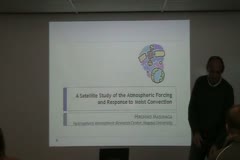
A Satellite Study of the Atmospheric Forcing and Response to Moist Convection
February 10, 2011
Hirohiko Masunaga (Nagoya U.)
Hosted by Chris Kummerow
In this talk a satellite data analysis is presented to explore the thermodynamic evolution of tropical and subtropical atmospheres prior and subsequent to moist convection, motivated to offer an observational testbed for convective adjustment central to the quasi-equilibrium hypothesis. Tropical Rainfall Measuring Mission (TRMM) and Aqua satellite measurements are projected onto a composite…
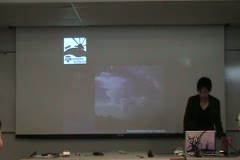
Cloud Thermodynamic Phase in the Infrared with AIRS
February 03, 2011
Shaima Naisiri (Texas A&M)
Hosted by Steve Miller
Whether clouds are composed of water droplets, ice crystals, or mixture of water and ice impacts precipitation, radiation, modeling, and remote sensing. In this presentation, I'll focus on the remote sensing of cloud thermodynamic phase using infrared satellite observations from the MODIS and AIRS instruments on the Aqua satellite. While cloud phase is a microphysical cloud property, from the…
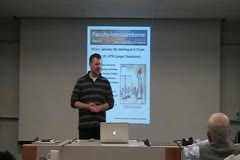
Faculty Intro Jamboree
January 20, 2011
Profs. Cotton, Collett, Kummerow, Randall, Rutledge, Schubert, Van den Heever
Hosted by Thomas Birner
5-10 min intros by individual faculty members to provide an overview of their research areas. Gather for cookies & snacks afterward.
